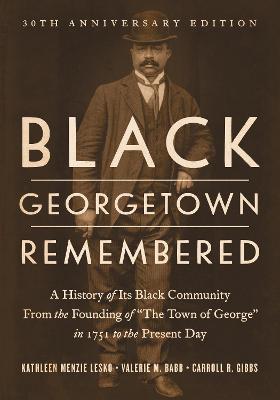“Black Georgetown Remembered” released its 30th anniversary edition containing interviews with Black Georgetown community members.
The book, which was originally published in 1991, details the vibrant and often underrecognized Black Georgetown community. Through interviews with Georgetown residents as well as with research from historical archives, the book explores Georgetown’s history from the university’s founding in the 18th century to the present. The third edition of the book includes a new chapter containing conversations, portraits, photographs and sketches of residents.
Inspiration for the new edition came from a documentary by the Georgetown University Press that featured stories of Georgetown’s Black community members, according to Kathleen Lesko, a co-author of the book and a former assistant English professor and program coordinator at Georgetown.

“I decided to do a book to follow up, and at the request of many of the Black Georgetowners who then started flurrying out of their homes and coming to my home and bringing their personal memorabilia, and I realized that the story is much larger and more comprehensive than the original film,” Lesko said in an interview with The Hoya.
As part of the university’s bicentennial celebration, the documentary entitled, “Black Georgetown Remembered,” was released, containing recollections of the neighborhood’s Black community who stayed in Georgetown despite the region’s history of enslavement and oppressive Jim Crow laws.
The university has its own ties to slavery after the Maryland Province of the Society of Jesus sold 314 enslaved people in 1838 — referred to as the GU272 — to financially sustain the university.
The documentary focused specifically on the 1940s and 1950s, when the demographic of the neighborhood changed drastically due to gentrification following an influx of predominantly white families and businesses moving to the area.
Lisa Fager, executive director of the Mount Zion Female Union Band Historic Memorial Park Foundation, a historic cemetery in the Georgetown neighborhood mentioned in the book, said the anniversary edition is a way to highlight the neighborhood’s Black history, especially how cemeteries play a role in it.
“The 30th anniversary is a great way to actually leverage again Black Georgetown to let people know particularly right now with what we’re experiencing with race and reconciliation and critical race theory. I feel like the cemetery is a great place to talk about facts, learn and unlearn things,” Fager said in an interview with The Hoya.
The exploration of Black history is critical in understanding the history of the United States, according to Neville Waters (GRD ’91), a sixth-generation Washingtonian and community activist whose family was featured in the book.
Many states have banned the teaching of critical race theory in schools, with opponents of the method citing that it is decisive and equating the theory with Marxism.
“While it is wonderful to be able to isolate and focus on and highlight Black history, in many ways, Black history is American history,” Waters said in an interview with The Hoya. “You know, it is all tied together. One does not necessarily exist in a vacuum.”
American history has often erased Black history in favor of the stories of white Americans with the mentioning of Black leaders and historical individuals often left out of history books.
Community members feel a sense of pride seeing their family’s history included in the books, according to Waters, whose own great-great-grandfather, Neville Waters, was included in the book.
“I can’t imagine that in 1856 for a Black man, I’m sure 84 was not the target age. So here is this man that lives this rich fulfilling life, and for his story to be told, that, if you will, has my DNA in it. So, I am very proud to be able to say those are my people,” Waters said in an interview with The Hoya.
The historical Waters was a property owner, worked for the federal government and became a leader in the Republican party, according to Waters.
“Black Georgetown Remembered” enables community members to preserve their heritage, according to Lesko.
“It is a fight to get the visibility and verification that their community deserves and their heritage deserves,” Lesko said. “And it is on the shoulders of the few who still live there, and they are continuing to go to the public meetings, to the citizens association meetings, to make their voices heard. They are very very determined to preserve their history, and these legacy projects are very important to them, because it is all they have left.”




















